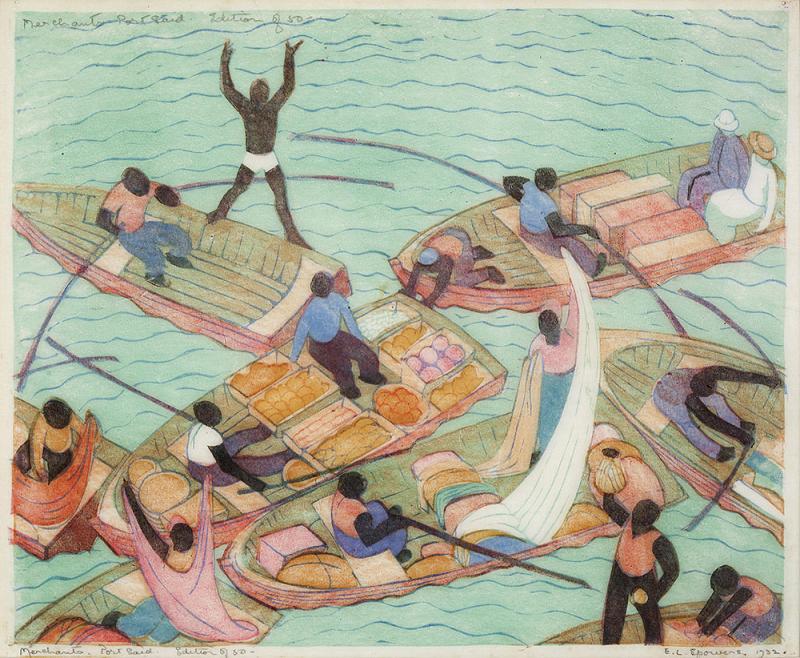ETHEL SPOWERS (1890-1947)
Merchants, Port Said 1932
Estimate: $30000 - 36000
Sold For:
$28,000 hammer
Description
ETHEL SPOWERS (1890-1947)
Merchants, Port Said 1932
colour linocut
25.0 x 30.5 cm
titled and numbered in pencil within image upper left
signed, dated, titled and inscribed beneath image
inscribed on backing board verso: 47/ 'Merchants, Port Said'/ Lent by EW Syme/ 102 Toorak Road/ S.Yarra
edition of 50
Provenance:
Collection of Eveline Syme, Melbourne
Collection of Mr and Mrs Oliver Lodge, Victoria, 1977
Private collection, Victoria
Private collection, Victoria
Exhibited:
Gladys Owen and Ethel Spowers, Grosvenor Galleries, Sydney, 6 December 1932, cat.5
Colour Prints and Contemporary Oils, Redfern Gallery, London, 1 June - 29 July 1933, cat.73
Exhibition of Pictures by Ethel Spowers, Everyman’s Lending Library, Melbourne, 28 November - 9 December 1933, cat.16
Reference:
Coppel, S., Linocuts of the Machine Age, Claude Flight and the Grosvenor School, Scolar Press, Aldershot, 1995, p.173, cat. E.S.19, (illus. p.174, another example)
Art in Australia, Sydney, April 1933, p.48 (illus.)
Estimate: $30000 - 36000
Result Hammer: $28,000
Ethel Spowers, a painter and printmaker, was a pivotal figure during one of the most iconic and stylistically rich movements in the history of Australian art. Notable for the extraordinary output of female artists, including Margaret Preston, Dorrit Black, Eveline Syme and Thea Proctor, modernism revolutionised art between the wars. Like many of her contemporaries, Spowers embraced the print medium as the ideal vehicle through which to explore her aesthetic sensibilities. A devotee of the linocut, Spowers was drawn to this resurgent technique as it suited her decorative style through surface flatness and simplicity of form, both key modernist tenants.
The powerful friendship between Spowers and Syme was at the nexus of both womens’ practice. Both were from wealthy newspaper owning families in Melbourne, and both staunch supporters of Modernism and the Arts and Crafts movement. Closely connected with the Arts and Crafts Society of Victoria, Spowers and Symes were outspoken proponents of modernism as exhibiting artists, published writers and lecturers.
In 1929 both women enrolled in classes at the Grosvenor School of Modern Art in London under the tutelage of the innovative printmaker, Claude Flight. Spowers together with contemporaries Cyril Power, Sybil Andrews and fellow Australians Black and Symes elevated the status of the linocut through their colourful and geometrically reduced designs, resulting in one of the most remarkable developments in twentieth century printmaking. The colour linocut evoked the vitality and spirit of the emergent era, expressing the speed and movement of the modern age.
Merchants, Port Said 1932, printed from six linoleum colour blocks: two shades of yellow ochre, cobalt blue, green, pink, and black, demonstrates the profound influence Flight had on Spowers’ practice. The colour block approach is deeply indebted to the experimental methods of the Grosvenor School. Here Flight rejected traditional approaches to colour relief printing in favour of developing the image using multiple colour blocks of similar value. He dispensed with the previous practice of using the final ‘key’ block to resolve the imagery through the addition of a layer of graphic detail in favour of progressively overlaying each colour to create form and tone. Flight believed that ‘the sooner the student in his colour work learns to consider each block as an arrangement of line and mass, and eliminates the all-line ‘key block’, the sooner he will produce work that is true to the medium, which is work that builds up block by block to a perfect whole.’1
Merchants, Port Said is an unusual subject within Spowers’ oeuvre which often favours images of children. The work relates to a watercolour Early Morning, Port Said 1932 with both images depicting life along the Suez Canal. In early 1931, Spowers and her family traveled by ocean liner to Europe, returning to Australia a year later. Merchants, Port Said, is a stylised representation of the scene observed by the artist during this journey. The fluidity of the composition is achieved through the blocks of colour, gradually overlayed to reveal the final image. The picture shows a collection of small boats laden with wares floating against the translucent blue background. Local peddlers populate the boats, jostling to sell goods to the liner’s passengers. Plumes of fabric punctuate the picture plane with blocks of soft colour, the entire scene, neatly encased in a weave of oars, enacts a sense of compositional harmony without a reliance on symmetry.
Spowers’ artistic profile and marketability have seen a significant resurgence in recent years culminating with a record sale for her linocut, Wet Afternoon 1929-30 which sold for more than fifty-one thousand pounds at Christie’s London sale in April 2011.
Footnotes
1. Claude Flight cited in Coppel, S., Linocuts of the Machine Age: Claude Flight and the Grosvenor School, Scolar Press in association with the National Gallery of Australia, United Kingdom, 1995, p.16
Alison Burns BA (Hons); MA
Location
SYDNEY VIEWING. 17 - 20 October 11am - 6pm. 12 Todman Avenue, Kensington
MELBOURNE VIEWING. 24 - 30 October 11am - 6pm. Stonnington Mansion, 336 Glenferrie Rd, Malvern
